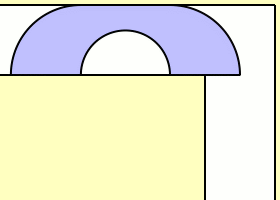Sofa problem
The sofa problem is a so far unsolved geometrical problem that was described in 1966 by the Austrian-Canadian mathematician Leo Moser . It is a two-dimensional idealization of the practical problem of moving furniture around obstacles.
The sofa problem is what is the two-dimensional, rigid shape with the largest area A that can be maneuvered around the right-angled corner within an L-shaped corridor of width 1 . The area A is called the sofa constant .
Upper and lower bounds
A semicircle with radius 1 can be transported around the corner by initially pushing the semicircle straight through to the limit. Now the corner coincides with the center of the base of the semicircle, and you can turn the semicircle around this point by 90 °. Then you can move the semicircle further. A first lower limit for the area is therefore .
John Hammersley found a shape with a much larger area . His sofa, shaped like a telephone receiver , consists of two quadrant areas on the sides of a large rectangle with side lengths 1 and , on the long side of which a semicircle with a radius has been cut in the middle .
Joseph Gerver found a sofa with a slightly larger area of 2.2195. Its axially symmetrical outline consists of 18 individual curves and is similar to Hammersley's sofa, in which the shape has been rounded. Although Gerver suspected that his sofa was optimal, formal proof has not yet been given.
Using a simple argument, Hammersley showed that there is an upper bound on the sofa constant. In June 2017, Yoav Kallus and Dan Romik proved a new upper bound of .
Trivia
The sofa problem is mentioned in the novel The Electric Monk by Douglas Adams , in which the protagonist's sofa can be maneuvered into a hallway, but not out.
Individual evidence
- ^ Hallard T. Croft, Kenneth J. Falconer, Richard K. Guy : Unsolved Problems in Geometry . Ed .: Paul R. Hamos (= Problem Books in Mathematics; Unsolved Problems in Intuitive Mathematics . Volume II ). Springer-Verlag, 1994, ISBN 978-0-387-97506-1 ( springer.com [accessed April 24, 2013]).
- ↑ a b Moving Sofa Constant ( Memento of January 7, 2008 in the Internet Archive ) Steven Finch, MathSoft contains an illustration of Hammersley's and Gerver's sofa.
- ↑ Joseph L. Gerver: On Moving a sofa Around a Corner . In: Geometriae Dedicata . 42, No. 3, 1992, pp. 267-283. ISSN 0046-5755 . doi : 10.1007 / BF02414066 .
- ↑ Eric W. Weisstein : Moving sofa problem . In: MathWorld (English).
- ^ Neal R. Wagner: The Sofa Problem . In: The American Mathematical Monthly . 83, No. 3, 1976, pp. 188-189. JSTOR 2977022 . doi : 10.2307 / 2977022 .
- ^ Ian Stewart : Another Fine Math You've Got Me Into… . Dover Publications, Mineola, NY January 2004, ISBN 0-486-43181-9 (accessed April 24, 2013).
- ↑ Yoav callus Dan Romik: Improved upper bounds in the moving sofa trouble . In: Metric Geometry . June 21, 2017. arxiv : 1706.06630 .







